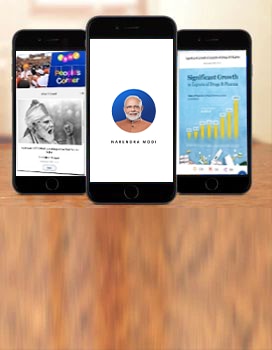Women have been central to the grand vision of New India of the government led by PM Narendra Modi. PM Narendra Modi has been at the forefront of raising awareness on gender equality and women empowerment. He says that India needs not just women development, but women-led development that makes women the leading force of our development trajectory. Accordingly, the NDA government is focusing on comprehensive women empowerment.
Protection and Empowerment of the Girl Child
Beti Bachao Beti Padhao initiative was launched in early 2015 to usher in a transformational shift in the way our society looks at the girl child. This initiative of the government has turned into a mass movement since its launch. There is a strong emphasis on mindset change through training, sensitization, awareness raising and community mobilization on the ground. Due to these efforts, the sex ratio at birth improved in 104 districts among those identified as gender-sensitive. 119 districts reported progress in first trimester registrations and 146 districts improved in institutional deliveries. Buoyed by the success of this initiative in these districts, BBBP has now been expanded across all 640 districts of the country.
Education plays an important role in empowering the girl child. Thanks to the relentless efforts of the government such as multiple scholarships for the education of girls, enrolment of girls in secondary schools is rising.
To ensure the financial security of the girl child, Pradhan Mantri Sukanya Samriddhi Yojana was introduced. Its resounding success is visible in the fact that more than 1.5 crore Sukanya Samriddhi accounts have been opened with more than Rs. 30,000 crore deposited in them.
Financial Inclusion and Empowerment
To boost financial empowerment of women, making them beneficiaries of formal financial institutions is a crucial, enabling step. The seriousness of government’s intent to take forward the vision of women led development could be gauged from the fact that it has been working round the clock to maximize women’s access to education, skill training and institutional credit.
The Pradhan Mantri Jan Dhan Yojana scheme has played a major role in the financial inclusion of women in the country. Over 18 crore women, both in rural and urban areas, for the first time, have access to formal banking and various financial services
Women have many skills that need financial capital that can help convert these skills into successful entrepreneurship opportunities. MUDRA Yojana was launched by PM Narendra Modi’s government to provide collateral-free loans to entrepreneurs and help them achieve their dreams. Another programme, Stand Up India, also provides entrepreneurship loans of up to Rs 1 crore to women or SC/ST entrepreneurs. Women have been at the forefront of making these programmes immensely successful. Over 10 crore women have availed entrepreneurship loans jointly from MUDRA and Stand Up India. Women constitute over 70% of MUDRA’s beneficiaries.
In the field of skill development, the participation of women has been phenomenal. Under the Pradhan Mantri Kaushal Vikas Yojana (PMKVY) 2.0, almost half of the beneficiaries enrolled are women. The scheme provides a boost to women’s competencies and skills, increasing their employability and enabling them to become self-employed. Skilling women labour force is also critical to the agenda of women empowerment, since, a strong workforce of skilled female workers would enhance women’s bargaining power at the workplace.
The cycle of exploitation can be broken by a woman who is financially independent and is confident of her capabilities. Education and skill augment a woman’s agency in her household as well as community. With financial autonomy, her decision-making power is heightened and duly acknowledged by the society at large.
Encouraging Working Women
A major reason of such many women opting out of work in the organized sector was the unavailability of adequate paid maternity leave, thus forcing women to choose between caring for their newborn and their career growth. The government has acted decisively by passing the Maternity Benefit (Amendment) Bill, 2017, increasing the maximum period of paid maternity leaves to 26 weeks from the existing period of 12 weeks. The progressive step puts India as among the top few countries in the world in this respect. The landmark law has given a new life to the vision of women-led development as propagated by PM Narendra Modi.
For the first time, women officers in the Indian army will be eligible for Permanent Commission. The paves the way for a full length career for women aspirants in the armed forces in the near future.There has also been significant push to the women working at the grassroots. The Modi government has announced slew of benefit packages for ASHA and Anganwadi workers including taking care of their social security and increasing allowances. This has come as a huge encouragement to the tireless work they are doing.
Pathbreaking Programmes for Welfare of Women
Pradhan Mantri Ujjwala Yojana and Swachh Bharat, both flagship programmes of the PM Narendra Modi led government, have become household names all across the country. Both of these programmes have raised the quality of life of crores of women, especially from the poorer sections.
Ujjwala Yojana, the programme that provides free LPG connections, has secured a smoke-free life for 6.7 crore women. It is helping them lead a healthy life while also helping them save the time and energy spent on looking for firewood.
Swachh Bharat has heralded a revolution in sanitation and helped women’s access to safe sanitation. Over 9.76 crore household toilets have been built and 5.52 lakh villages across 28 states/UTs have been declared ODF (open defecation free).
To help the presence of immovable assets in the name of women, the Pradhan Mantri Awas Yojana gives preference to women.
Passport rules have been relaxed for single mothers so that they can get formalities done without any problems.
Thus, the NDA government, under the leadership of PM Narendra Modi, has ensured great strides in empowering women, by not just focusing on women development but on women-led development.





















